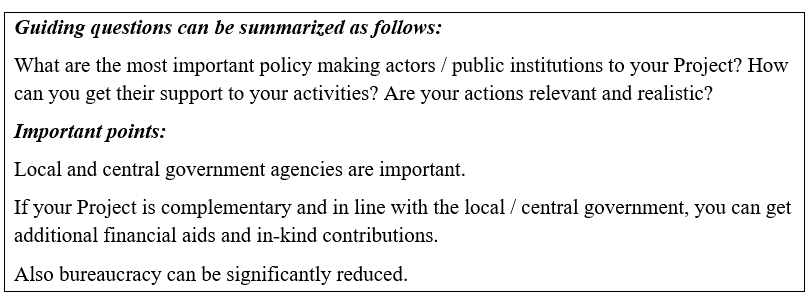Political sustainability is important to ensure the publicity, public ownership, lobbying, securing funds/resources, reducing bureaucracy for the Project processes and activities. Political sustainability is important both for the implementation and post-implementation. Because it affects other types of sustainability (Scoones, 2016, 297).
In the implementation process, receiving political support can increase the publicity of the Project to relevant public institutions.
You can affect legislation and policy making processes related with your Project topic to achieve a desired goal or facilitate processes in a specific area which you need to address.
You can reduce the bureaucracy in any part of your Project. This will ensure that your activities can be carried out in time and properly.
You may get additional resources to carry out your activities. Public institutions may provide training rooms, office areas, supplies, funds etc.
You may reach your target group more easily and efficiently by using the network and channels.
In order to ensure political sustainability, you can include one or more active policy maker actors as partners. Local administrations can be an optimal choice since it is easy to reach them. Central government organizations can be challanging. However, if you or your partners have a network or connection with the central government organizations, you can increase your projects’ impact substantially. In that manner, you can also take an important NGO or lobbying/think-tank institutions as partners to establish a connection with the central government body related with your Project topic.
Another way to reach / affect the policy makers, public institutions in the area is to conduct dissemination, visibility, valorization, promotion activities. These can be listed as contact making seminars, workshops, networking events, conferences, focus meetings, establishing connections with the head of the relevant institution (Smucker, 2005). Official letters with information documents can be another way to reach the institutions via official channels. Since the public institutions should provide an answer to your letters, it would create an opportunity to introduce and promote the Project. Also, it is possible to reach these institutions via social media or digital platforms, however the chances of success would be significantly lower.
In the end, you need to clearly state in the proposal that the measures you will take to receive the political support and thus ensure the sustainability. You need to incorporate these actions in the relevant parts of the Project proposal. It would be more effective for you to held meetings with the institutions that can provide political sustainability before the submission of the proposal. So you can justify your actions easily. It can be even better if you have an agreement with the policy maker / public institution, so you can annex it to your proposal.



